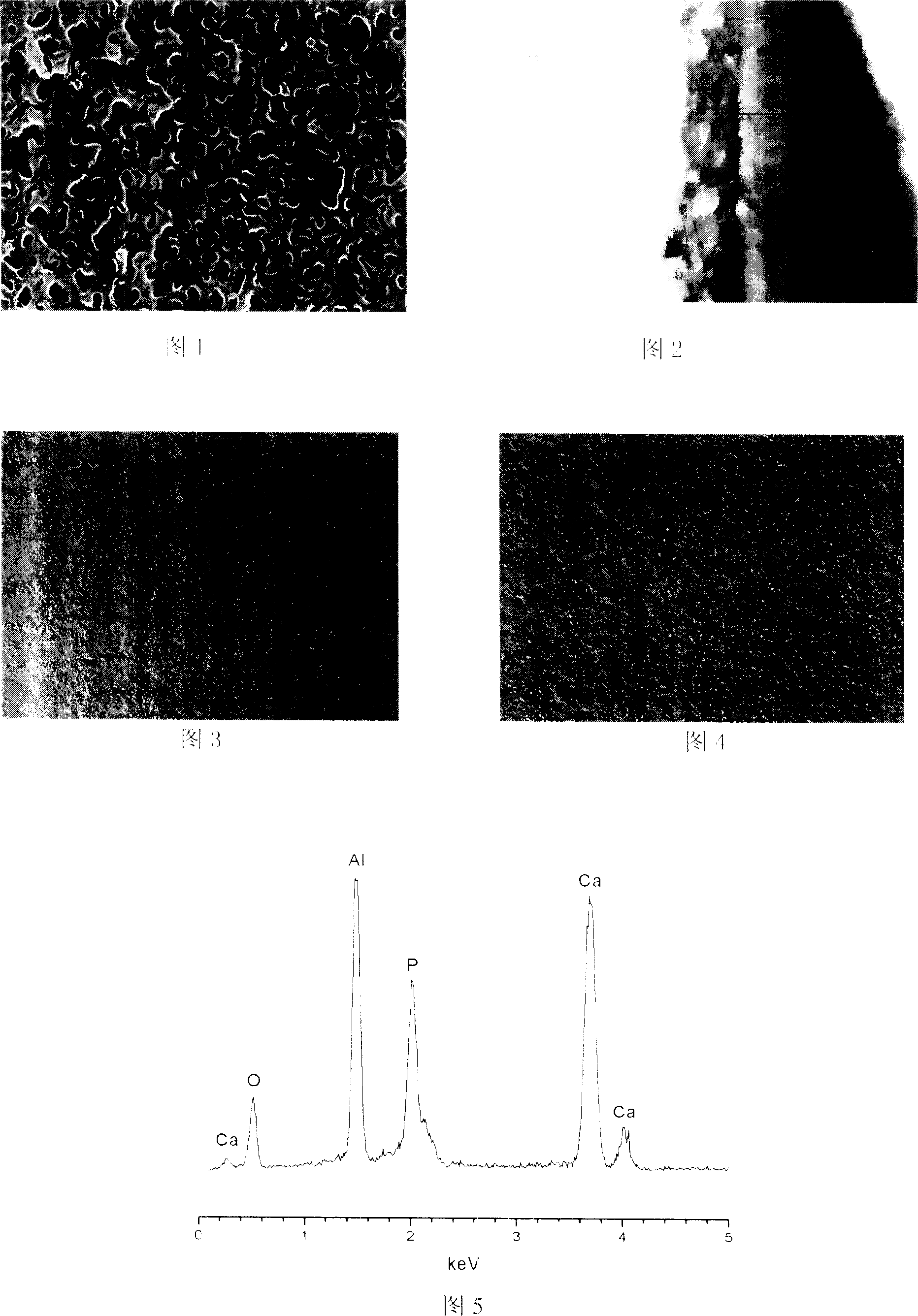Process for preparing composite coat of hydroxy apatite and aluminum oxide
A hydroxyapatite and composite coating technology, applied in coating, electrolytic coating, electrophoretic plating, etc., can solve the problems of coating peeling and harmful
- Summary
- Abstract
- Description
- Claims
- Application Information
AI Technical Summary
Problems solved by technology
Method used
Image
Examples
Embodiment 1
[0029] 1. Substrate pretreatment: (1) Mechanical polishing: Take a titanium sample with a thickness of 0.8mm and cut it into a sample with a size of about 30mm×10mm, and then mechanically polish it with 100#, 800#, 1200# water-grinding sandpaper until the surface is uniform bright. (2) Alkali elution means: add 10g sodium carbonate, 10g sodium phosphate, and 5g sodium silicate in 500mL deionized water in sequence, heat to dissolve, then add 2.5mL polyethylene glycol octylphenyl ether (OP-10 ),well mixed. Pour out about 50mL, put all the polished titanium samples into the alkaline washing solution, boil for 5min, then transfer to an ultrasonic cleaner and sonicate for 5min. After taking it out, rinse it with tap water to completely remove the residual lye on the surface. (3) Acid etching: first add a certain amount of deionized water to a graduated 500mL plastic bottle, then add 50mL HF (40wt%) and 150mL concentrated HNO 3 (65-68wt%), shake well, add deionized water to the 5...
Embodiment 2
[0036] 1. Substrate pretreatment: (1) Mechanical polishing: Same as in Example 1. (2) Alkali elution means: same as embodiment 1. (3) Acid etching: first add a certain amount of deionized water to a graduated 500mL plastic bottle, then add 40mL HF (40wt%) and 120mL concentrated HNO 3 (65-68wt%), shake well, add deionized water to the 500mL mark, shake well. Pour out about 50mL into a plastic beaker, put the alkali-washed titanium samples into treatment one by one, and the treatment time is about 40s. After taking them out, put them into running water to rinse immediately to quickly remove the residual acid on the surface. After cleaning, the samples were soaked in deionized water for later use.
[0037] 2. Micro-arc oxidation: Pour 120mL of distilled water into a 200mL beaker in advance, and measure 4mL of concentrated H with a pipette. 2 SO 4 (98wt%) is added in the beaker under stirring, is mixed with electrolytic solution, and after cooling, the beaker is put into the w...
Embodiment 3
[0043] 1. Substrate pretreatment: (1) Mechanical polishing: replace titanium with TC4 titanium alloy, and the rest are the same as in Example 1. (2) Alkali elution refers to: add 7.5g sodium carbonate, 7.5g sodium phosphate, 2.5g sodium silicate in 500mL deionized water in sequence, heat to dissolve, then add 2mL polyethylene glycol octylphenyl ether (OP -10), mix well. Pour out about 50mL, put all the polished titanium samples into the alkali washing solution, boil for 5 minutes, then transfer to an ultrasonic cleaner for 5 minutes of ultrasonic cleaning. After taking it out, rinse it with tap water to completely remove the residual alkali solution on the surface. (3) acid etching: with embodiment 1.
[0044] 2. Micro-arc oxidation: Pour 120mL of distilled water into a 200mL beaker in advance, and use a pipette to measure 5mL of concentrated H 2 SO 4 (98wt%) is added in the beaker under stirring, is mixed with electrolytic solution, and after cooling, the beaker is put int...
PUM
| Property | Measurement | Unit |
|---|---|---|
| Thickness | aaaaa | aaaaa |
| Surface area | aaaaa | aaaaa |
| Strength | aaaaa | aaaaa |
Abstract
Description
Claims
Application Information
 Login to View More
Login to View More - R&D
- Intellectual Property
- Life Sciences
- Materials
- Tech Scout
- Unparalleled Data Quality
- Higher Quality Content
- 60% Fewer Hallucinations
Browse by: Latest US Patents, China's latest patents, Technical Efficacy Thesaurus, Application Domain, Technology Topic, Popular Technical Reports.
© 2025 PatSnap. All rights reserved.Legal|Privacy policy|Modern Slavery Act Transparency Statement|Sitemap|About US| Contact US: help@patsnap.com

